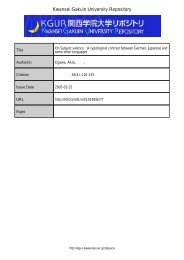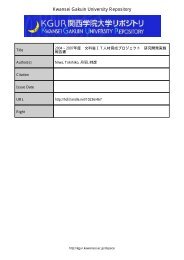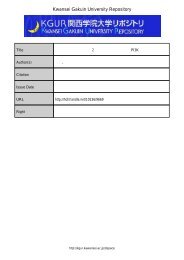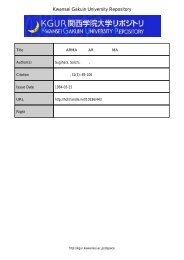Kwansei Gakuin University Repository
Kwansei Gakuin University Repository
Kwansei Gakuin University Repository
You also want an ePaper? Increase the reach of your titles
YUMPU automatically turns print PDFs into web optimized ePapers that Google loves.
cannot be identified, although the month and year of exit for most bankruptcies<br />
are available in the data source. However, according to TSR, researchers from TSR<br />
collect and maintain firms’ information by telephone, postal questionnaire, and field<br />
surveys several times a year. If a firm is found to exit, the firm’s information is no<br />
longer updated. Therefore, using information on the accounting period when the<br />
last statement of accounts before exit was reported, we identify the year of exit for<br />
firms that have exited because of voluntary liquidation or merger, including those<br />
few bankruptcies of firms with a total deficit of less than 10 million yen. For these<br />
firms, the year when the final statement of account was reported is regarded as the<br />
year of exit, and we analyze yearly data from 1997 to 2004. 10<br />
3.3. Method<br />
Our interest is to estimate the probability that a new firm will exit at a certain age<br />
and to identify factors affecting the three forms of exit. However, some firms do<br />
not exit during the observation period; that is, duration is right censored. For this<br />
reason, previous literature has applied the PH model to the survival and exit of new<br />
establishments or firms over time (e.g., Audretsch and Mahmood, 1991, 1995; Mata<br />
et al., 1995; Honjo, 2000a). As already mentioned, the PH model has advantages<br />
because it can accommodate the right-censored observations.<br />
In this paper, the post-entry performance of new firms is divided into survival<br />
and, as discussed above, the three forms of exit: bankruptcy, voluntary liquidation,<br />
and merger. Schary (1991) assumed, although her analysis did not focus on new<br />
firms, that the forms of exit are inherently ordered as follows: survival, merger,<br />
nonfailure, and failure. However, it cannot be reasonably assumed that this order<br />
10 However, this conjecture of the year of exit may still have a bias. Therefore, we predicted<br />
the year of exit for all forms of exit, including for firms with a total deficit greater than or equal<br />
to 10 million yen, based on the year of the last reported statement of account and estimated the<br />
determinants of exit using the CPH model, which is explained below. As a result, we did not find<br />
large changes in our estimation results, regardless of the prediction methods for the year of exit.<br />
Instead of the CPH model, we also used a multinomial logit model as a robustness check. The<br />
results were generally consistent with those reported in Section 5.<br />
11
















